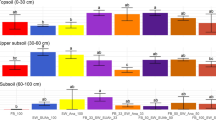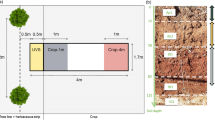Abstract
Roots of trees (Sesbania sesban) and crops (Zea mays) were quantified during two tree/crop cycles in a sequential tree — crop system at Chipata, Eastern Zambia. The experiment included one- and two-year fallows as well as fertilized and unfertilized controls. The roots of S. sesban represent a standing biomass in the soil of 3 Mg hat-1 in the top 1.5 m after two years, with 45–60% and 70–75% being in the top 25 and 50 cm respectively. S. sesban fallow improved early rooting and growth of the following maize crop. Increased soil infiltration was also observed in the two-year fallow treatment, as well as decreased bulk density and resistance to penetration in the soil. No differences between maize root parameters could be detected at tasselling, nor differences between nutrient status of the different treatments. Study results indicate that under the drought-prone conditions of Eastern Zambia, where improved soil physical conditions are important for early deep rooting of crops and access to water and nutrients, tree roots could play an important role in the fallow effect. Further studies are required to assess the relative importance of the improvement of soil chemical and physical properties.
Similar content being viewed by others
References
Adejuwon JO and Adesina FA (1990) Organic matter and nutrient status of soils under cultivated fallows: an example of Gliricidia sepium fallows from South Western Nigeria. Agrofor Syst 10: 23–32
Amir J, Krikun J, Orion D, Putter J and Klitman S (1991) Wheat production in an arid environment. 1. Water-use efficiency as affected by management practices. Field Crops Res 27(4): 351–364
Anderson JM and Ingram JSI (1993) Tropical Soil Biology and Fertility, A Handbook of Methods, 2nd ed. CAB International, Wallingtord, Oxon, UK, 221 pp
Berish CW (1982) Root biomass and surface area in three successional tropical forests. Can J For Res 12: 699–704
Berish CW and Ewel JJ (1988) Root development in simple and complex tropical successional systems. Plant and Soil 106: 73–84
Coutts MP (1989) Factors affecting the direction of growth of tree roots. Ann Sci For 46 (suppl): 277S–287S
Dierolf TS, Arya LM and Yost RS (1989) Root distribution in an alley cropping system. Nitrogen Fixing Trees Res Rep 7: 9–11
Drechsel P, Glaser B and Zech W (1991) Effect of four multipurpose tree species on soil amelioration during tree fallow in central Togo. Agrofor Syst 16: 193–202
Floret C and Serpantié G (1993) La jachére en Afrique de l'Quest. ORSTOM, Paris, 494 pp
Gomez KA and Gomez AA (1984) Statistical Procedures for Agricultural Research, 2nd ed. IRRI, The Philippines and Wiley, New York, 680 pp
Hairiah K and van Noordwijk M (1986) Root Studies on a Tropical Ultisol in Relation to Nitrogen Management. Instituut voor Bodemvruchtbaarheid, Haren, The Netherlands, Rapport 7–86, 116 pp
Hairiah K and van Noordwijk (1989) Root distribution of leguminous cover crops in the humid tropics and effects on a subsequent maize crop. In: van der Heide J (ed) Nutrient Management for Food Crop Production in Tropical Farming Systems, pp 157–169. Institute for Soil Fertility, Haren, The Netherlands and Universitas Brawijaya, Malang, Indonesia
Jean S (1993) Jachéres et stratégies fonciéres. In: Floret C and Serpantié G (eds) La jachére en Afrique de l'Quest, pp 47–54. ORSTOM, Paris
Karachi M (1995) Sesbania species as potential hosts to root-knot nematode (Meloidogyne javanica) in Tanzania. Agrofor Syst 32: 119–125
Kass DL, Foletti C, Szott LT, Landaverde R and Nolasco R (1993) Traditional fallow systems of the Americas. Agrofor Syst 23(2–3): 207–218
Kwesiga F (1990) The potential of Sesbania sesban in the traditional land use systems of Zambia. In: Macklin W and Evans DO (eds) Perrenial Sesbania sesban Species in Agroforestry Systems, pp 131–138. ICRAF, Nairobi
Kwesiga F and Coe R (1994) The effect of short rotation Sesbania sesban planted fallows on maize yield. For Ecol Manage 64: 199–208
Lal R (1987) Tropical ecology and physical edaphology. J Wiley & sons, Chichester, 744 pp
Lal R (1991) Myths and scientific realities of agroforestry as a strategy for sustainable management of soils in the tropics. Adv Soil Sci 15: 91–135
Oliver R and Ganry F (1994) Etude des modifications de fertilité induites par une jachére arborée. Cas de la zone forestiére de Centre Côte d'Ivoire. CIRAD, Montpellier, 30 pp
O'Toole JC and Bland WL (1987) Genotypic variation in crop plant root systems. Adv Agron 41: 91–145
Peltier R (1993) Les jachères à composante ligneuse: caractérisation, productivité, gestion. In: Floret C and Serpantié G (eds) La jachère en Afrique de l'Quest, pp 67–87. ORSTOM, Paris
Piéri C (1989) Fertilité des terres de savane — bilan de 30 ans de Recherche et de Développement Agricole au Sud du Sahara. Ministr`ere Coopération et Développement et CIRAD, Paris, 444 pp
Ruhigwa BA, Gichuru MP, Mambani B and Tariah NM (1992) Root distribution of Acioa barteri, Alchornea cardifolia, Cassia siamea and Gmelina arborea in an acid Ultisol. Agrofor Syst 19: 67–78
Schroth G (1995) Tree root characteristics as criteria for species selection and systems design in agroforestry. Agrofor Syst 30: 125–143
Szott LT, Palm CA and Sanchez PA (1991) Agroforestry in acid soils of the humid tropics. Adv Agron 45: 275–300
Veldkamp WJ Muchinda M and Delmotte AP (1984) Agroclimatic zones in Zambia. Soil Bulletin No. 9, Soil Survey Unit, Land Use Branch, Department of Agriculture, Republic of Zambia
Vogt KA, Vogt DJ and Bloomfield J (1991) Input of organic matter to the soil by tree roots. In: McMichael BL and Persson H (eds) Plant Rootsand Their Environment, pp 171–190. Elsevier Science Publishers, The Netherlands
Author information
Authors and Affiliations
Additional information
Submitted as ICRAF Journal Article # 95/28.
Rights and permissions
About this article
Cite this article
Torquebiau, E.F., Kwesiga, F. Root development in a Sesbania sesban fallow-maize system in Eastern Zambia. Agroforest Syst 34, 193–211 (1996). https://doi.org/10.1007/BF00148162
Issue Date:
DOI: https://doi.org/10.1007/BF00148162




